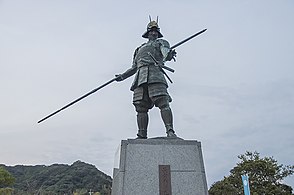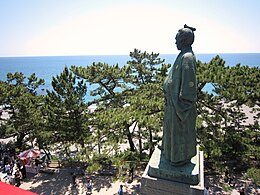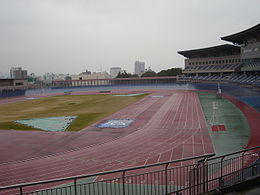|
Kōchi, Kōchi
Kōchi (高知市, Kōchi-shi, pronounced [koːtɕi ꜜɕi]) is the capital city of Kōchi Prefecture located on the island of Shikoku in Japan. With over 40% of the prefectural population, Kōchi is the main commercial and industrial centre and the "primate city" of the prefecture. As of 1 April 2023[update], the city had an estimated population of 318,520 in 154,048 households, and a population density of 1,000 persons per km2.[2] The total area of the city is 309.00 square kilometres (119.31 sq mi). OverviewA symbol of the city is its most famous dish, katsuo tataki, made by lightly searing and seasoning bonito.[3] Cityscape
Geography Kōchi is located on the southern coast of Kōchi Prefecture, facing the Pacific Ocean to the south. The city area can be divided into three distinct geographic sections. The urban centre lies at the head of Urado Bay, in a narrow alluvial plain crossed by several rivers, notably the Kagami River and Kokubu River. The plain is bounded by mountains to the north and a range of hills to the south and west. The northern mountains form the least densely populated part of the city, with the only settlement being along narrow river valleys. The highest point in Kōchi is Kuishi-yama at 1,176 metres (3,858 ft). To the south of the city centre, Urado Bay cuts through the hills to its outlet into the Pacific Ocean. The land surrounding the bay and a small strip of the coastline form the third part of the city. This area, although hillier and less dense than the plain, is nevertheless a major location of housing and port-related industry. Neighbouring municipalitiesKōchi Prefecture ClimateKōchi has a very wet humid subtropical climate (Köppen climate classification Cfa), receiving twice as much rainfall as Shikoku's other chief cities Matsuyama and Takamatsu. It is also the most typhoon-prone of Japan's major cities owing to its location directly exposed to the open Pacific Ocean from which the storms enter the country, and has twice received over 50 cm (20 in) of rainfall in a day from a typhoon.
DemographicsPer Japanese census data,[5] the population of Kōchi increased rapidly in the 1960s and 1970s before peaking around the year 2000 and going into decline.
HistoryFeudal periodAs with all of Kōchi Prefecture, the area of Nahari was part of ancient Tosa Province. The river plain now containing the city centre was originally settled as a castle town around Kōchi Castle, the seat of the daimyō of Tosa Domain. The castle site was chosen by Yamauchi Kazutoyo in 1601 to replace the earlier seats of the Chōsokabe clan who had previously ruled in province. The city takes its name from that of the castle. As the centre of administration for the province, and the prefecture which succeeded it, the town rapidly grew to become the largest settlement of the region. Meiji periodDuring the time of the Meiji Restoration, Kōchi became famous as a centre of pro-imperial ideology, and later for incubating democratic and human rights movements. The city was incorporated on April 1, 1889, with the establishment of the modern municipalities system.. Tram service began in the city on May 2, 1904, and the city was connected to the national rail network on November 12, 1951. WWII air raidKōchi was selected as a target by the United States' XXI Bomber Command because of the city's status as a prefectural capital, and the fact that it was a centre for industry and commercial trade. On July 3, 1945, at 6:22 pm (JST) 129 aircraft took off to bomb Kōchi. 1060 tons of incendiary bombs were dropped on Kōchi, destroying 48% of the built up areas of the city, killing 401 civilians and rendering over 40,000 homeless.[6] Modern periodOn April 1, 1998, the city was designated as the first core city on Shikoku. On January 1, 2005, the villages of Kagami and Tosayama, both from Tosa District were merged into Kōchi. On January 1, 2008, the town of Haruno (from Agawa District) was also merged into Kōchi. Government Kōchi has a mayor-council form of government with a directly elected mayor and a unicameral city council of 42 members. The current mayor (since 2023) is Ryugo Kuwana.[7] Kōchi contributes 15 members to the Kōchi Prefectural Assembly. In terms of national politics, the city is divided between the Kōchi 1st district and Kōchi 2nd districts of the lower house of the Diet of Japan. International relationsInternational
National
Education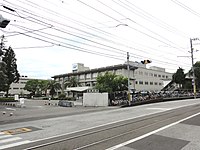  UniversitiesKōchi is home to two universities, Kōchi University (national) and University of Kochi (prefectural), and four junior colleges including Kochi Junior College.
Schools
Kōchi has 39 public elementary schools, 17 public middle schools and one public high school operated by the city government, one private and one national elementary school, and five private combined middle/high schools. The city has eight public high schools administered by the Kōchi Prefectural Department of Education. The prefecture also operates one middle school and one combined middle/high school. Transport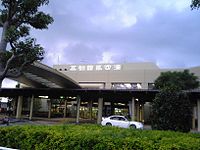 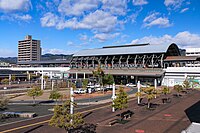    Airport
RailwaysKōchi is located on the JR Shikoku's Dosan Line connecting it to northern Shikoku, and via interchanges with the Tosa Kuroshio Railway to the eastern and western parts of Kōchi Prefecture. JR's central station in Kōchi is Kōchi Station. Conventional lines
TramwaysThe most visible form of transport within Kōchi is the tram service run by Tosaden Kōtsū. Its three lines with historic cars service the major north–south and east–west axes of the city. BuswaysThe city also has an extensive bus network. HighwaysKōchi is also serviced by the Kōchi interchange of the Kōchi Expressway which connects to the national expressway system. ExpresswayJapan National Route
Seaways
Tourism  Kōchi Castle still exists in its pre-restoration form, and is one of the main tourist attractions. Other places of interest in the city centre are the Obiyamachi (帯屋町) shopping arcade, the regular Sunday street markets which are close to a kilometre in length, and Harimayabashi (はりまや橋), a bridge that featured in a famous Kōchi song about the forbidden love of a Buddhist priest. Local attractionsThe mountain Godaisan (五台山) holds a public park with views of the city, and is home to stop 31 on the Shikoku Pilgrimage, Chikurin-ji, as well as the Makino Botanical Garden. Off Museum Road (Kenritsu Bijutsukandori) is The Museum of Art, Kōchi, where the main collection is composed of expressionistic works related to Kōchi.[9] The Former Yamauchi Residence and Tosa Yamauchi Family Treasury and Archives are also to be found in the city.
Historic spots
The Shinto Shrine Tosa jinja is located to the west.[10]
Temples No.30 (Zenrakuji, No.31(Chikurin-ji) and No.33 (Sekkei-ji) on the Shikoku Pilgrimage are located in the city. At the mouth of Urado Bay, the remnants of Urado Castle (an earlier provincial seat) stand above Katsurahama, a famous beach with an aquarium and statue of the Kōchi hero Sakamoto Ryōma. Nearby on the grounds is the Sakamoto Ryōma Memorial Museum.[11] Culture   Festival・Events
Kōchi's most famous festival is the Yosakoi which is held in August. Teams of dancers dance to traditional and modern songs at various places around Kōchi. The total number of dancers is in the thousands.
Gourmet
Museums
Sports
Notable people from Kōchi
References
External linksWikivoyage has a travel guide for Kōchi. Wikimedia Commons has media related to Kochi, Kochi.
|
|||||||||||||||||||||||||||||||||||||||||||||||||||||||||||||||||||||||||||||||||||||||||||||||||||||||||||||||||||||||||||||||||||||||||||||||||||||||||||||||||||||||||||||||||||||||||||||||||||||||||||||||||||||||||||||||||||||||||||||||||||||||||||||||||||||||||||||||||||||||||||||||||||||||||||||||||||||||||||||||||||||||||||||||||||||||||
Portal di Ensiklopedia Dunia












